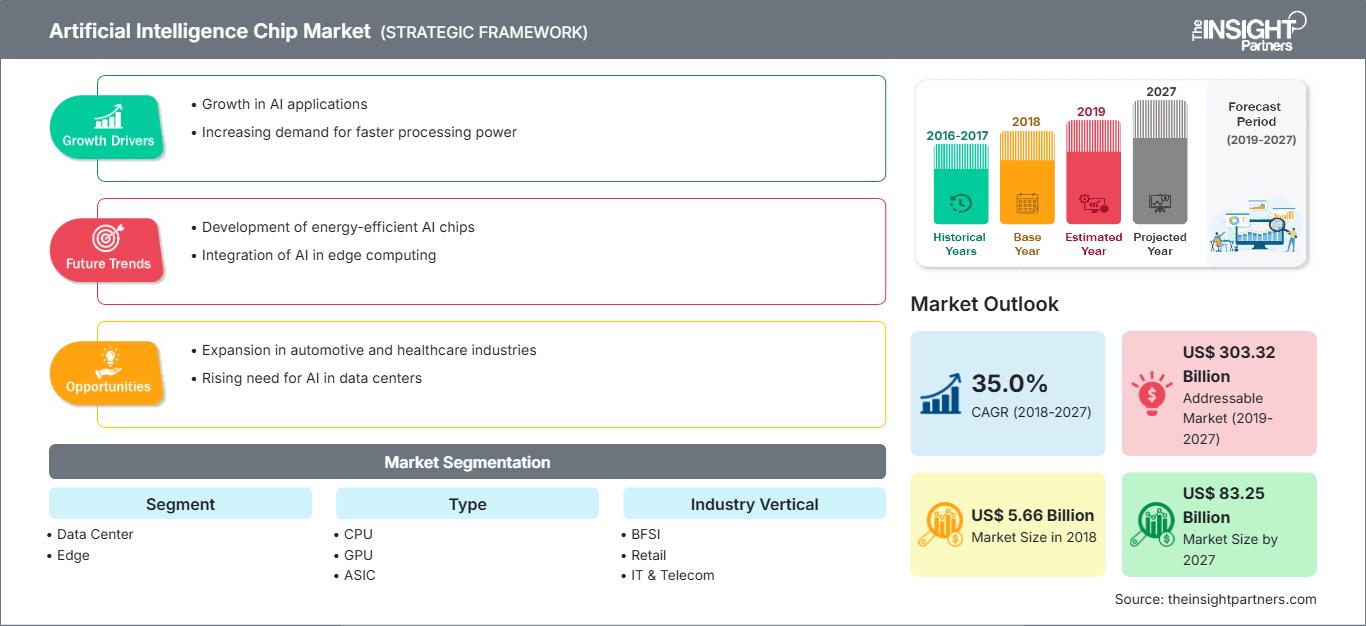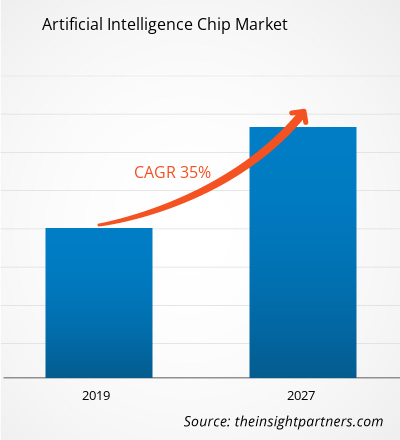인공지능 칩 시장은 2018년 5조 6,581억 달러 규모였으며, 2027년에는 832억 5,270만 달러에 이를 것으로 예상됩니다. 2019년부터 2027년까지 연평균 성장률(CAGR)은 35.0%에 달할 것으로 예상됩니다.
지난 몇 년 동안 방대한 양의 데이터와 클라우드 기반 컴퓨팅 성능의 확장성 덕분에 인공지능은 산업 전반에 걸쳐 큰 트렌드로 자리 잡았습니다. 오늘날의 디지털 세계에서 정보는 기업의 성공과 지속 가능한 성장을 위한 핵심 요소입니다. 대부분의 산업, 특히 서비스 부문은 유용한 비즈니스 통찰력을 제공하고 시장에서 경쟁력을 유지하기 위해 분석에 크게 의존합니다. 기업들은 이전에는 프로그래밍 방식이나 수동으로 진행되었던 비즈니스 프로세스를 지속적으로 자동화해 왔습니다. AI 칩의 발전과 애플리케이션별 맞춤형 칩의 도입으로 기업은 이제 실시간 분석을 수집하고 데이터를 실행 가능한 통찰력으로 전환할 수 있게 되었습니다. 인공지능 칩 시장에서는 다양한 수직 분야에 걸쳐 AI가 성공적으로 구현되고 있는 수많은 사용 사례가 있습니다.
AI 칩이 사용되는 주요 인공지능 응용 분야에는 머신 러닝(ML), 자연어 처리(NLP), 전문가 시스템, 자동 음성 인식, AI 계획 및 컴퓨터 비전이 있습니다.
요구 사항에 맞게 이 보고서를 사용자 정의하십시오.
이 보고서의 일부, 국가 수준 분석, Excel 데이터 팩을 포함하여 모든 보고서에 대한 사용자 정의를 무료로 받을 수 있을 뿐만 아니라 스타트업 및 대학을 위한 훌륭한 제안 및 할인을 이용할 수 있습니다
인공지능 칩 시장: 전략적 통찰력

- 이 보고서의 주요 주요 시장 동향을 확인하세요.이 무료 샘플에는 시장 동향부터 추정 및 예측에 이르기까지 데이터 분석이 포함됩니다.
시장 통찰력– 인공지능 칩 시장 AI 칩 스타트업에 대한 투자 증가로 예측 기간 동안 시장이 활성화될 전망
이 보고서의 일부, 국가 수준 분석, Excel 데이터 팩을 포함하여 모든 보고서에 대한 사용자 정의를 무료로 받을 수 있을 뿐만 아니라 스타트업 및 대학을 위한 훌륭한 제안 및 할인을 이용할 수 있습니다
인공지능 칩 시장: 전략적 통찰력

- 이 보고서의 주요 주요 시장 동향을 확인하세요.이 무료 샘플에는 시장 동향부터 추정 및 예측에 이르기까지 데이터 분석이 포함됩니다.
인공지능과 머신 러닝, 딥 러닝과 같은 응용 분야는 지난 몇 년 동안 엄청나게 성장해 왔습니다. AI는 클라우드 컴퓨팅 애플리케이션부터 디지털 비서, 자율주행차에 이르기까지 다양한 분야에서 광범위하게 활용되고 있습니다. AI 사용 사례가 증가하고 시장 환경이 변화함에 따라 현재 칩의 발전은 필수가 되었습니다. AI는 주로 NVIDIA가 시장을 선도하는 데이터 센터 교육 시장에서 사용됩니다. 그러나 애플리케이션별 맞춤형 AI 칩과 엣지 및 데이터 센터 추론에 대한 수요는 AI 칩 시장에서 빠르게 성장하는 부문이며, 이 시장을 개척하기 위해 많은 신생 기업이 등장하고 있습니다.
세그먼트 통찰력
세그먼트를 기준으로 인공지능 칩 시장은 데이터 센터/클라우드와 엣지 애플리케이션으로 나뉩니다. 데이터 센터는 2018년 글로벌 시장 점유율에서 가장 큰 비중을 차지했습니다. 현재 인공 지능 칩의 주요 적용 분야는 데이터 센터/클라우드 애플리케이션입니다. 데이터 센터의 AI 칩은 학습 및 추론 목적으로 사용됩니다. 학습은 AI 알고리즘이 데이터를 분석하고 학습한 후, 해당 정보를 활용하여 실제 문제에 대응하는 과정입니다. 학습 과정에서 AI 알고리즘은 막대한 양의 데이터를 분석합니다. 개발자가 AI 기술 개발 프로세스를 단축할 수 있도록 칩 제조업체는 프로세서 성능 향상에만 집중할 것이 아니라 하드웨어, 프레임워크 및 기타 지원 도구를 포함하는 전체 생태계를 제공해야 합니다.
유형별 인사이트
유형별로 인공 지능 칩 시장은 CPU, ASIC, GPU, FPGA 등으로 구분됩니다. GPU 유형 부문은 2018년 글로벌 시장 점유율에서 가장 큰 비중을 차지했습니다. 현재 인공 지능 애플리케이션에서 그래픽 처리 장치(GPU)는 가장 널리 사용되는 하드웨어입니다. GPU는 높은 병렬 처리 성능과 메모리 대역폭 덕분에 머신 러닝 및 딥 러닝 애플리케이션, 특히 학습에 가장 적합한 옵션입니다. GPU는 원래 그래픽 렌더링에서 실행되는 수많은 곱셈 및 덧셈 연산을 가속화하는 데 사용되었습니다. 고성능 그래픽에 대한 수요가 증가함에 따라 강력한 GPU에 대한 수요도 증가했습니다.
시장 참여자들은 경쟁사와의 경쟁을 위해 제품에 첨단 기술과 기능을 통합하여 신제품 혁신과 개발에 집중하고 있습니다.
- 2019년 3월, AMD는 ScaleMP와 파트너십을 체결하여 AMD 서버 OEM이 4개, 8개, 최대 128개의 프로세서 소켓, 최대 8,192개의 CPU, 256테라바이트의 공유 메모리를 갖춘 시스템을 구축할 수 있도록 했습니다.
- 2018년 7월, Google은 온디바이스 머신 러닝을 위한 소형 AI 칩인 Edge TPU를 출시했습니다. Edge TPU는 Google이 엣지에서 AI를 실행하도록 특별히 제작한 주문형 반도체(ASIC)입니다. 작은 물리적 및 전력 소모량으로 높은 성능을 제공하여 엣지에서 고정확도 AI를 배포할 수 있습니다.
인공지능 칩 시장 지역별 통찰력
The Insight Partners의 분석가들은 예측 기간 동안 인공지능 칩 시장에 영향을 미치는 지역별 동향과 요인들을 면밀히 분석했습니다. 이 섹션에서는 북미, 유럽, 아시아 태평양, 중동 및 아프리카, 그리고 중남미 지역의 인공지능 칩 시장 부문 및 지역별 현황도 살펴봅니다.
인공지능 칩 시장 보고서 범위
| 보고서 속성 | 세부 |
|---|---|
| 시장 규모 2018 | US$ 5.66 Billion |
| 시장규모별 2027 | US$ 83.25 Billion |
| 글로벌 CAGR (2018 - 2027) | 35.0% |
| 이전 데이터 | 2016-2017 |
| 예측 기간 | 2019-2027 |
| 다루는 세그먼트 |
By 세그먼트
|
| 포함된 지역 및 국가 | 북미
|
| 시장 선도 기업 및 주요 회사 프로필 |
|
인공지능 칩 시장 참여자 밀도: 비즈니스 역학에 미치는 영향 이해
인공지능 칩 시장은 소비자 선호도 변화, 기술 발전, 그리고 제품 이점에 대한 인식 제고 등의 요인으로 인한 최종 사용자 수요 증가에 힘입어 빠르게 성장하고 있습니다. 수요가 증가함에 따라 기업들은 제품 라인업을 확장하고, 소비자 니즈를 충족하기 위한 혁신을 추진하며, 새로운 트렌드를 적극 활용하고 있으며, 이는 시장 성장을 더욱 가속화하고 있습니다.

- 을 얻으세요 인공지능 칩 시장 주요 주요 플레이어 개요
- 데이터 센터
- 에지
인공지능 칩 시장 - 유형별
- CPU
- GPU
- ASIC
- FPGA
- 기타
인공지능 칩 시장 - 산업별
- BFSI
- 소매
- IT 및 통신
- 자동차 및 운송
- 헬스케어
- 미디어 및 엔터테인먼트
- 기타
인공지능 시장 - 지역별
북미
- 미국
- 캐나다
- 멕시코
유럽
- 프랑스
- 독일
- 이탈리아
- 러시아
- 영국
- 유럽의 나머지 지역
아시아 태평양(APAC)
- 한국
- 중국
- 인도
- 호주
- 일본
- 아시아 태평양의 나머지 지역
중동 및 아프리카(MEA)
- 사우디아라비아
- UAE
- 남아프리카공화국
- MEA 기타 지역
남아메리카(SAM)
- 브라질
- 아르헨티나
- 남아메리카 기타 지역(SAM)
인공지능 칩 시장 - 기업 프로필
- Advanced Micro Devices, Inc.
- Google, Inc.
- Huawei Technologies Co., Ltd
- IBM
- Intel Corporation
- Micron Technology, Inc.
- NVIDIA Corporation
- QUALCOMM Incorporated
- Samsung Electronics Co., Ltd.
- Xilinx, Inc.
- 과거 분석(2년), 기준 연도, CAGR을 포함한 예측(7년)
- PEST 및 SWOT 분석
- 시장 규모 가치/거래량 - 글로벌, 지역, 국가
- 산업 및 경쟁 환경
- Excel 데이터세트
최근 보고서
사용 후기
구매 이유
- 정보에 기반한 의사 결정
- 시장 역학 이해
- 경쟁 분석
- 고객 인사이트
- 시장 예측
- 위험 완화
- 전략 기획
- 투자 타당성 분석
- 신흥 시장 파악
- 마케팅 전략 강화
- 운영 효율성 향상
- 규제 동향에 발맞춰 대응




















 무료 샘플 받기 - 인공지능 칩 시장
무료 샘플 받기 - 인공지능 칩 시장